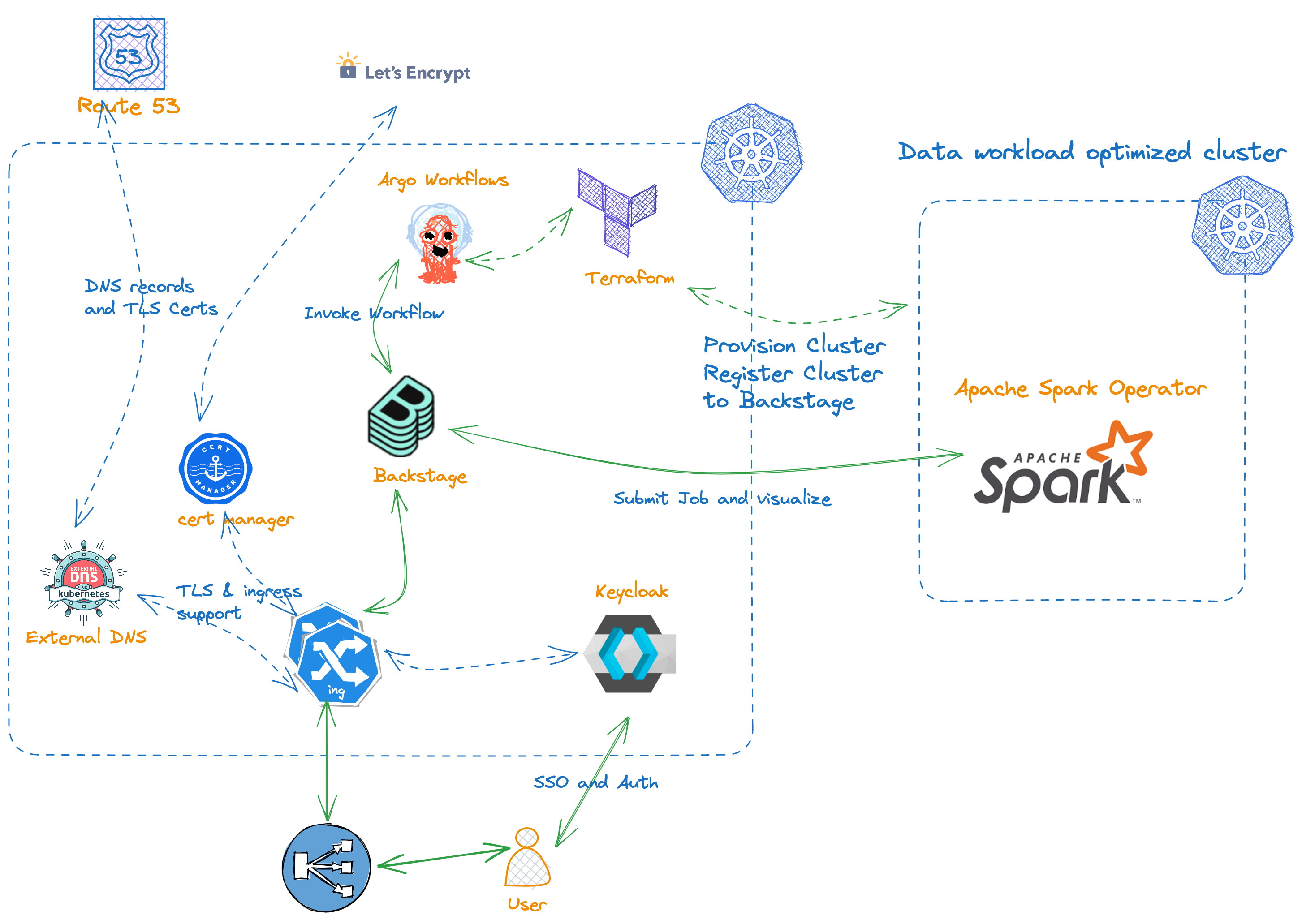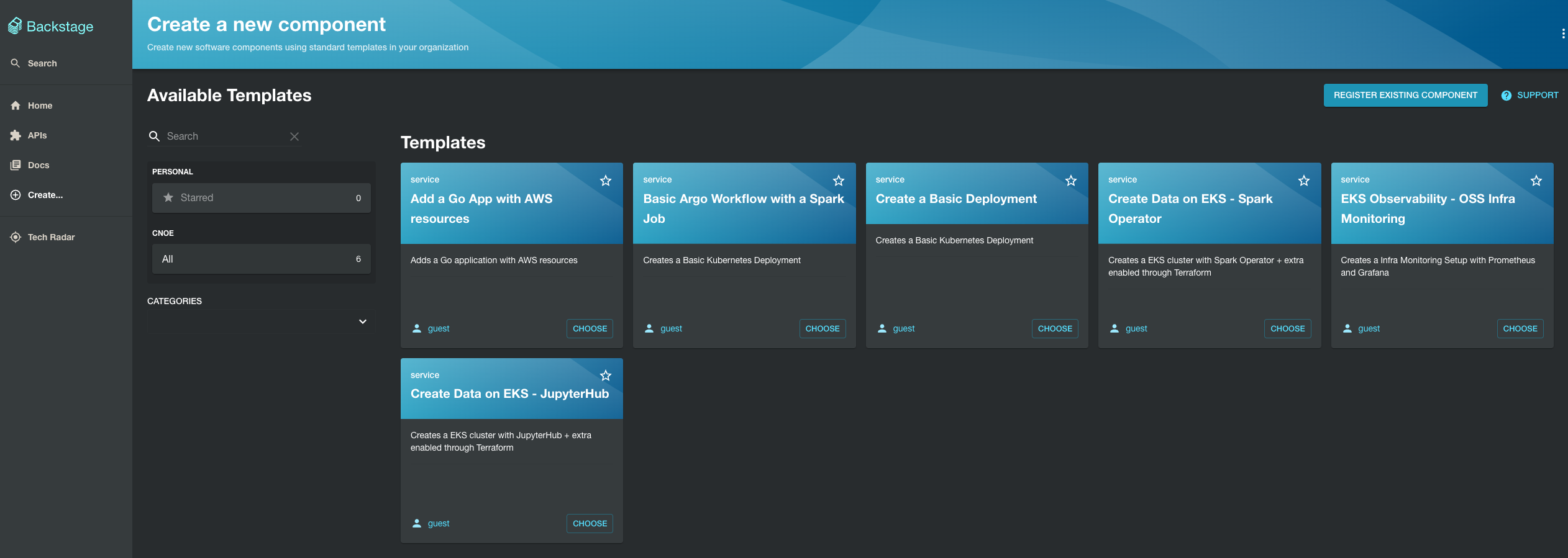💥 Seamlessly use Backstage Terraform Integrations with the rest of the CNOE stack!
WORK IN PROGRESS: Current the repository is in POC stage. The integrations assume you have enabled Terraform integrations either with the idpbuilder or that you have deployed flux controller and tf-controller on the Amazon EKS deployment. We will continuously evolve this to add more more features such as supporting full lifecycle of components such as delete, update etc., and integrate newer AWS maintained terraform based open source solutions in future.
Backstage Terraform integrations serve as a powerful bridge, seamlessly extending the capabilities of cnoe-io's reference implementations, such as idpbuilder and reference-implementations-aws. This integration enables these reference implementations to harness the full potential of AWS-maintained, Terraform-based open-source solutions, including data-on-eks and aws-observability-accelerator.
By leveraging these Terraform integrations, Backstage becomes a versatile platform that can effortlessly incorporate cutting-edge AWS technologies and services. This synergy empowers developers and architects to construct robust, scalable, and highly observable platform templates tailored to their specific needs.
The integration process is a symphony of automation and efficiency. Terraform, with its declarative approach to infrastructure as code, orchestrates the provisioning and configuration of the desired AWS resources. This streamlined process ensures consistency, reproducibility, and adherence to best practices across multiple environments, from development to production.
Moreover, the integration with AWS-maintained open-source solutions brings a wealth of expertise and community-driven innovation to the table. Solutions like data-on-eks and aws-observability-accelerator are meticulously crafted by AWS experts, incorporating industry-leading practices and architectural patterns. By harnessing these solutions, developers can benefit from battle-tested architectures, enhanced security, and optimized performance, all while reducing the time and effort required for implementation.
The seamless integration of Terraform and AWS-maintained open-source solutions within Backstage empowers organizations to unlock new realms of possibilities. Whether it's deploying highly available and scalable data platforms on Amazon Elastic Kubernetes Service (EKS) or implementing comprehensive observability solutions for monitoring, logging, and tracing, Backstage becomes a powerful catalyst for innovation and digital transformation.
With Backstage Terraform integrations, organizations can confidently embrace the latest AWS technologies, accelerate time-to-market, and deliver robust, secure, and highly observable platform templates that drive business value and competitive advantage.
We might need a container engines such as Docker Desktop, Podman to run backstage terraform integrations locally. Please check this documentation to setup your container engine.
version=$(curl -Ls -o /dev/null -w %{url_effective} https://github.com/cnoe-io/idpbuilder/releases/latest)
version=${version##*/}
curl -L -o ./idpbuilder.tar.gz "https://github.com/cnoe-io/idpbuilder/releases/download/${version}/idpbuilder-$(uname | awk '{print tolower($0)}')-$(uname -m | sed 's/x86_64/amd64/').tar.gz"
tar xzf idpbuilder.tar.gz
./idpbuilder version
# example output
# idpbuilder 0.4.1 go1.21.5 linux/amd64or use the following installation script:
curl -fsSL https://raw.githubusercontent.com/cnoe-io/idpbuilder/main/hack/install.sh | bashUse the following command to deploy idpbuilder and ensure that the Backstage Terraform integration Argo application is part of your setup.
idpbuilder create \
--use-path-routing \
-p https://github.com/cnoe-io/stacks//ref-implementation \
-p https://github.com/cnoe-io/stacks//terraform-integrationsOptional: Add AWS Credentials
In case of deploying AWS resources, you will need access to your AWS account. You can follow the instructions below, to setup your AWS account with CNOE terraform integrations:
export AWS_ACCESS_KEY_ID=<FILL THIS>
export AWS_SECRET_ACCESS_KEY=<FILL THIS>
# Optional for IAM roles
export AWS_SESSION_TOKEN=<FILL THIS>
# AWS Credentials for flux-system Namespace for TOFU Controller
cat << EOF > ./aws-secrets-tofu.yaml
---
apiVersion: v1
kind: Secret
metadata:
name: aws-credentials
namespace: flux-system
type: Opaque
stringData:
AWS_ACCESS_KEY_ID: ${AWS_ACCESS_KEY_ID}
AWS_SECRET_ACCESS_KEY: ${AWS_SECRET_ACCESS_KEY}
# Add this only if it's required. Optional for IAM roles
AWS_SESSION_TOKEN: ${AWS_SESSION_TOKEN}
EOF
kubectl apply -f ./aws-secrets-tofu.yaml
You can optionally install the catalog by adding it to the Backstage config.
In case of the idpBuilder:
- clone the cnoe-io/stacks repository
- navigate to
./ref-implementation/backstage/manifests/install.yaml - add the following lines for catalog location under
data."app-config.yaml".catalog.locations
- type: url
target: https://github.com/cnoe-io/backstage-terraform-integrations/blob/main/backstage-templates-for-eks/catalog-info.yaml
rules:
- allow: [User, Group]
Then run the following idpbuilder command to update the components with path-to-stacks-repo referring to the location where you cloned the cnoe-io/stacks repository.
idpbuilder create \
--use-path-routing \
-p [path-to-stacks-repo]/ref-implementation \
-p https://github.com/cnoe-io/stacks//terraform-integrationsAlternatively, you can take the target link above and directly register it as a component with Backstage, and all the respective components in the catalog will appear in the Backstage catalog.
Run this command to obtain all the credentials needed to log in to Backstage, Argo, etc.
idpbuilder get secretsUse the credentials from the above secrets output.
- Login to Argo: https://cnoe.localtest.me:8443/argocd
- Login to Backstage: https://cnoe.localtest.me:8443/
- Login to Gitea: https://cnoe.localtest.me:8443/gitea
Please follow the following steps if you are looking to delete a component created using the backstage terraform integrations. The Terraform resources in this repo are configured to clean up the corresponding cloud resources. When the Argo CD application is deleted, the deletion hook for cloud resources kicks in (takes a little bit of time though).
- In your argocd console, navigate to your application created for your component and delete it manually.
- In your gitea console, the created repository for your component and delete it manually under settings.
- Finally in your backstage console, navigate to component and click on
unregister componentto remove the deleted component from backstage.
If you'd like to contribute to the project or know the architecture and internals of this project, check out the contribution doc.
We will actively working to evolve this to add more more features such as supporting full lifecycle of components such as delete, update etc., and integrate newer AWS maintained terraform based open source solutions in future.
We welcome all individuals who are enthusiastic about Kubernetes to become a part of this open source solution. Your contributions and participation are invaluable to the success of this project.
If you have any questions or need clarifications on topics covered here, please feel free to reach out to us on the #cnoe-interest channel on CNCF Slack.
Built with ❤️.
Support is provided on a best effort basis. If you have feedback, feature ideas, or wish to report bugs, please use the Issues section of this GitHub.


